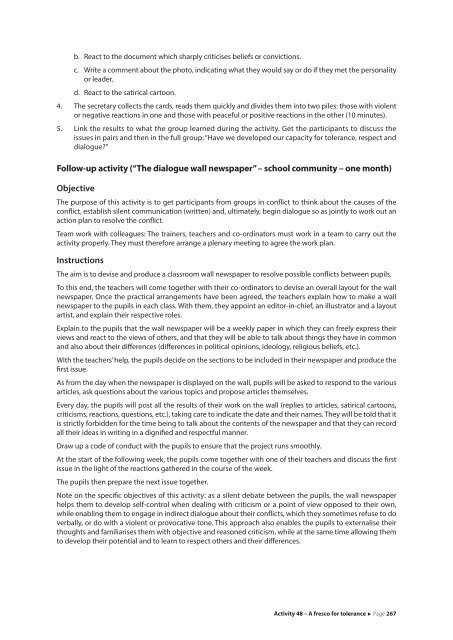TASKs for democracy
4NYw4W
4NYw4W
Create successful ePaper yourself
Turn your PDF publications into a flip-book with our unique Google optimized e-Paper software.
. React to the document which sharply criticises beliefs or convictions.<br />
c. Write a comment about the photo, indicating what they would say or do if they met the personality<br />
or leader.<br />
d. React to the satirical cartoon.<br />
4. The secretary collects the cards, reads them quickly and divides them into two piles: those with violent<br />
or negative reactions in one and those with peaceful or positive reactions in the other (10 minutes).<br />
5. Link the results to what the group learned during the activity. Get the participants to discuss the<br />
issues in pairs and then in the full group: “Have we developed our capacity <strong>for</strong> tolerance, respect and<br />
dialogue?”<br />
Follow-up activity (“The dialogue wall newspaper” – school community – one month)<br />
Objective<br />
The purpose of this activity is to get participants from groups in conflict to think about the causes of the<br />
conflict, establish silent communication (written) and, ultimately, begin dialogue so as jointly to work out an<br />
action plan to resolve the conflict.<br />
Team work with colleagues: The trainers, teachers and co-ordinators must work in a team to carry out the<br />
activity properly. They must there<strong>for</strong>e arrange a plenary meeting to agree the work plan.<br />
Instructions<br />
The aim is to devise and produce a classroom wall newspaper to resolve possible conflicts between pupils.<br />
To this end, the teachers will come together with their co-ordinators to devise an overall layout <strong>for</strong> the wall<br />
newspaper. Once the practical arrangements have been agreed, the teachers explain how to make a wall<br />
newspaper to the pupils in each class. With them, they appoint an editor-in-chief, an illustrator and a layout<br />
artist, and explain their respective roles.<br />
Explain to the pupils that the wall newspaper will be a weekly paper in which they can freely express their<br />
views and react to the views of others, and that they will be able to talk about things they have in common<br />
and also about their differences (differences in political opinions, ideology, religious beliefs, etc.).<br />
With the teachers’ help, the pupils decide on the sections to be included in their newspaper and produce the<br />
first issue.<br />
As from the day when the newspaper is displayed on the wall, pupils will be asked to respond to the various<br />
articles, ask questions about the various topics and propose articles themselves.<br />
Every day, the pupils will post all the results of their work on the wall (replies to articles, satirical cartoons,<br />
criticisms, reactions, questions, etc.), taking care to indicate the date and their names. They will be told that it<br />
is strictly <strong>for</strong>bidden <strong>for</strong> the time being to talk about the contents of the newspaper and that they can record<br />
all their ideas in writing in a dignified and respectful manner.<br />
Draw up a code of conduct with the pupils to ensure that the project runs smoothly.<br />
At the start of the following week, the pupils come together with one of their teachers and discuss the first<br />
issue in the light of the reactions gathered in the course of the week.<br />
The pupils then prepare the next issue together.<br />
Note on the specific objectives of this activity: as a silent debate between the pupils, the wall newspaper<br />
helps them to develop self-control when dealing with criticism or a point of view opposed to their own,<br />
while enabling them to engage in indirect dialogue about their conflicts, which they sometimes refuse to do<br />
verbally, or do with a violent or provocative tone. This approach also enables the pupils to externalise their<br />
thoughts and familiarises them with objective and reasoned criticism, while at the same time allowing them<br />
to develop their potential and to learn to respect others and their differences.<br />
Activity 48 – A fresco <strong>for</strong> tolerance Page 267


